Growing roses in the garden - planting and caring for the queen of flowers
rose flower is a plant from the rosehip family. The flower is popular for its variety of colors and shapes and aromatic fragrance. With proper care, roses grow in all climates. Flowers are widely used in landscape design. Roses are used to decorate flower beds, flower beds, borders and hedges. Caring for rose bushes is not always easy and requires some experience and skill.
The ancient Greeks called the rose "a gift from the gods" and the flower got its name from the ancient Greek poetess Sappho. The earliest descriptions of roses reveal Hindu and Iranian ancient scrolls. The Muslim people claim that the flower was created by the great Allah and took the place of the beautiful but lazy lotus. The rose has existed for about forty million years and during all this time it has not surrendered its royal positions, but only strengthens them, constantly winning the hearts of people.
Content:
- Description of spray roses
- Growing features
- Growing conditions for roses
- How to choose the right seedlings
- Landing dates and rules
- Autumn and spring planting of roses
- Caring for roses in the garden
- Pruning rules and timing
- Diseases and pests
- Breeding methods for roses
- Popular types and varieties of garden roses
- Rosary breakout options
Description of spray roses
Roses can be of different types and, accordingly, form bushes of different shapes and heights. In some varieties it is a compact pyramidal bush, in others it is spreading. The bushes form the main (uterine) and annual shoots, covered with unpaired oval leaves with finely cut edges. The length of the flowering stem varies from 9 to 85 cm, the flowers are small and large with a diameter of 3-20 cm of various shapes and shades. The buds consist of 5 or 120 petals, which grow singly or form inflorescences.
Depending on the shape of the buds, roses can be peony, pompom, cup-shaped, cone-shaped, spherical, flat.
Coloring of flowers has a wide range, except for blue shades. Roses of different types growing in the garden are pollinated every year and can gradually change their colors. Besides the beautiful flowering pink blossoms exude an amazing enveloping aroma.
Growing features
In rosaries, the most common are multi-flowered, climbing and hybrid tea forms of plants. In professionals, you can observe a dwarf, ground cover and erect high form of roses.
For the cultivation of garden roses, agricultural techniques are used. To date, more than twenty thousand varieties have become widespread. The rose is considered a flower queen and requires proper care.
For successful cultivation, you need to know all her "whims":
- Roses of the new generation tolerate winter frosts better, but still they will have to be covered for the winter, given the volume of the bushes.
- Annual pruning of rose bushes is carried out, both forming and sanitary.And also it is imperative to perform the autumn pruning secondary flowering bushes.
- Roses will look great both in group plantings and as an independent culture. It is actively used to decorate alpine slides and hedge.
- In order for the rose to become the queen of the garden to constantly delight with its flowering, competent planting and care of the flower will be required.
Growing conditions for roses
Rose has a positive attitude towards moderate heat and sunlight. But it should not be direct sunlight, because in the active sun the flowers wither faster and there is a risk of burns and burnout of plant leaves.
The optimal site for planting is a place well lit by the sun, but at noon, when the sun is especially dangerous, the rose should be protected from it.
The northern and northeastern winds should not be allowed, and the southern winds will suit the plant's taste. If the groundwater is close to the surface, then drainages should be placed in the planting holes and high beds should be formed. Loamy plants are generous fertilized soil. The best fertilizer for a flower is rotted mullein... When a place for planting is selected and prepared, you need to decide on the seedlings.
How to choose the right seedlings
When buying seedlings, you need to choose bushes with well-ripened stems. The degree of ripening can be determined by pushing the thorn from the side. A shoot is considered mature if the thorn is easily detached from the trunk. In the event that the thorns bend and do not break off, then the plant may not take root. An indicator of quality planting material is the bark, which should be juicy and lively, and the roots on the cut are yellowish-whitish.
For experienced gardeners, it will not be difficult to determine the variety by type seedlings... For example:
- If the trunk is covered with multiple thorns of different sizes, then the rose is a wrinkled variety.
- A seedling with sparsely spaced large thorns belongs to a loose rose.
- Strong pink crescent thorns indicate belonging to the white rose cultivar.
- And powerful paired, bent down at the Floribunda variety.
One-year and two-year seedlings are best suited for planting. You should not purchase planting material with a shriveled trunk and dry roots.
Landing dates and rules
The best time for landing and the purchase of seedlings is considered the autumn season - September and October. With a spring purchase, there is a risk of purchasing last year's planting material. Before buying, you need to carefully examine the seedlings and choose healthy and strong ones.
It must be remembered that roses cannot be planted where they grew before.
Landing rules:
- with a sharpened and processed garden tool, the roots of the seedlings are shortened, dry are removed, the stem is cut to a height of 16-20 cm and placed in water until the planting itself
- dig a landing hole 50x50 cm in diameter and 10 cm deep more than the roots with an earthen clod and loosen the bottom
- the excavated earth is mixed with fertilizers (3 pieces of land and 1 piece compost) and add charcoal. A bucket of water with heteroauxin is poured into the wells.
To make the roses take root faster:
- the seedlings should be held back while they are covered with earth so that the roots remain straightened
- you need to make a recess around the trunk for watering
- the planted seedling is spud at least fifteen centimeters and shaded for 10-12 days
- next watering carried out after 2 days
The spacing between bushes and rows depends on the type of rose and ranges from 1 to 2 meters.
Autumn and spring planting of roses
Autumn planting:
- Preparation begins 2-3 months before the landing event. If the groundwater comes close to the surface, you should start organizing the flower bed and laying drainage under it. Otherwise, the seedlings may begin to rot of the roots and the bushes will look sick.
- You need to prepare in advance soil compositionthat will match roses.Dig up the soil, adding humus and fertilizers, add manure or garden compost (1 bucket per 1 m2), bone meal or wood ash (2 cups each) and superphosphate (40-60 g). Too clay soil is diluted with sand (1-2 buckets per 1 m2).
- For the winter, roses planted in the fall need to be covered with earth completely.
Spring planting:
- Roses are planted from April to May.
- As with the autumn planting, the soil is prepared in advance.
- For seedlings, you need to shorten the elongated roots and cut off dry and damaged ones. The stems are cut to a height of 10-15 cm, leaving 3-4 buds.
- If the seedlings have dried roots, they need to be kept in water for at least a day, and on the eve of planting they should be treated with a clay-manure mixture.
- The prepared soil is poured with a mound into the planting hole and a seedling is placed in the middle, which is held as it is covered with earth. The soil must be compacted to avoid the formation of air cushions.
- After planting, the rose needs to be abundantly to water and spud.
- When the first sprouts appear, you need to level the earthen mound and mulch the soil around the trunk. For this, peat or humus is used. The thickness of the mulch layer should be at least 6-7 cm. For non-remontant varieties, mulch from wood chips or pine bark is used.
Caring for roses in the garden
After planting, rose bushes form within a year, and the main purpose of this period is to pinch the tips of the shoots. This manipulation promotes the growth of the bushes. At the beginning of summer, the buds that have emerged should be removed, because flowering can weaken the young plant.
Roses are very fond of water and the lack of moisture causes the growth of young shoots to stop, foliage withers and falls, the rose loses its decorative effect.
The plant should be watered especially intensively during the period of growth and appearance of buds and leaves, as well as after the first flowering... Melt and rain water is suitable for irrigation. Watering carried out into the prepared recess. Gradually, over several times, you should use up to 15 liters of water. Care must be taken so that water does not fall on the foliage. Such irrigation should be carried out once a week, and in dry weather with an interval of 3-4 days.
Features of watering in the fall:
- in August and September, abundant watering can harm the roses. Excess moisture leads to continued development and young branches do not have time to mature and quickly die during the first frost. Therefore, at the end of the season, artificial watering of roses is stopped.
- in hot autumn, roses are watered moderately, up to 12 liters per bush, so that there is enough moisture for the winter period
Top dressing:
- Mulch the soil before the buds open. Mulch is prepared from peat, humus or compost and covered with a layer of at least 10 cm. As a result, the soil is saturated with microelements and contributes to the intensive development of the plant.
- Top dressing the first ode is carried out regularly - three times a year. From the second year, roses should be fertilized thoroughly. At the same time, one should not forget that different fertilizers are needed at different times of the year.
- The combination of minerals and organics has a special effect. Organic fertilizers improve the quality of the soil, but work more slowly.
- Rose bushes are fed with dry fertilizers after rains or watering. Fertilizer is scattered around the bushes, stepping back 15 cm from the trunks, and then re-watered.
- With clay soil, fertilizing is carried out less often, and with sandy soil - more often.
- During intense color, feeding is stopped.
Pruning rules and timing
In spring, roses wake up after winter and begin to grow actively: buds are laid, the flowering stem is strengthened, new shoots grow. Underdeveloped (dormant) processes may appear and should be removed.
Pruning of "sleeping" shoots is carried out on 1-2 leaves and the rose is fed with liquid organic or mineral fertilizers.
Later, new stronger processes will appear.If weak shoots appear in the fall, then they are not cut off, since the plant will weaken, and new branches will not have time to ripen before the cold weather.
Diseases and pests
The rose is subject to various diseases and attacks pests... They fight with chemicals. Also used are folk remedies in the form of a soap-oil emulsion. To prepare it, use washing powder, diesel fuel or machine oil (5-6 tablespoons each), which are stirred in one liter of hot water. This mixture is diluted with ten liters of cold water and sprayed on the plants, which is carried out in the evening in calm weather.
Aphids, mites and thrips are effectively destroyed by garlic or onion tincture.
Often rose bushes are affected powdery mildew... Against this infection, prepare an aqueous solution of soda ash with laundry soap. For prophylaxis in the fall, dry foliage should be removed and burned.
The most common diseases and pests of roses:
- aphid
- powdery mildew
- red spider mite
- leaf bee
- caterpillars, snails and slugs
- bacterial cancer
- gray rot
- leaf spot
- viral diseases
- frothy slobber ("cuckoo saliva")
Reproduction methods
When propagating roses, vegetative and generative (seed) methods are used. Vegetative ones include: dividing the bush, grafting, reproduction by children, offsets and grafting.
Growing from seeds:
- This method is used to develop new varieties and hybrids and is practiced exclusively for wild roses.
- Seeds harvested from reddened seed pods at the end of summer. They need to be cleaned and placed in damp sand for four months.
- With the arrival of spring, the seeds are soaked in a root-forming solution for several hours.
- Sow seeds to a depth of 1-3 cm. Top soil mulch.
- After 2-3 leaves grow back, thin out, leaving an interval between plants of about 10 cm, and between rows up to 20 cm.
In the summer, mineral dressing is applied. Follow-up care is standard. At the end of summer, grown seedlings are used as a stock.
Cuttings:
- For rooting, lignified and semi-lignified cuttings are used. The collection of planting material is carried out during flowering.
- Length stalk should be at least 8 centimeters and the upper cut is made 5 mm above the kidney, and the lower one is made at an angle of 45 degrees.
- All thorns and leaves are removed from the cutting, leaving only the top two, which are shortened in half.
- The lower cut is treated with phytohormone before rooting.
- Cuttings are planted with an interval of 20-30 cm in a shaded place in a trench with sand, which is tamped around the cutting, watered and covered with polyethylene.
Periodically, the film is removed, providing oxygen to the plants. Follow-up care consists of watering and top dressing, removing weeds and loosening. The buds that appear are removed, and for the winter, the cuttings are covered with a two-layer insulation and a film. In the spring, the insulation is removed, and the film shelter is left. The film is periodically opened to harden the plant. So roses are grown for 2 years, and on the third they are transplanted into a rose garden.
Vaccination - rules of conduct:
- To clear the root collars from the ground and remove the lateral processes.
- Make a T-shaped incision on the neck and gently push the edges of the bark apart.
- Select the desired cutting, remove the foliage and the upper part from it.
- Cut off the peephole with the wood (the movement should be from the bottom up) and remove excess bark.
- The cut eye must be inserted into the incision rootstock and fix it with a tight bandage, and wrap it with foil on top.
- After three weeks, the kidney is checked for survival - it should be swollen, but not blackened.
- For the winter, the plant is spud. And in the spring, the stock is cut 1 cm above the scion.
- The grown sprout is pinched.
- In the fall, the plant can transplant.
Popular varieties of garden roses
There are about 40 species and 300 varieties of roses. Garden roses combine polyanthus and floribunda.They are characterized by a bouquet bloom formed from several inflorescences. Polyanthus roses have small flowers, and floribunda (a hybrid of polyanthus and tea-hybrid) are large. Garden roses are distinguished by a variety of shades and the degree of doubleness of the inflorescences. Plant height reaches 80 cm.
The most common garden rose varieties include:
- Stuttgardia or Cordes 2012 - Immune to diseases foliage. It has an erect, branched bush. It blooms profusely and for a long time in double rich yellow flowers that do not fade from the sun.
- Westzeit or Noack 2004 - has an unusual color of semi-double flowers of orange, apricot and pink shades. It has a light aroma. The height of the bush reaches 70 cm.
- Erfordia or Matthews 2002 - deep red double flowers with long flowering until frost. Reaches a height of 1.3 meters.
- Sinea - has a burgundy color of inflorescences. Young shoots with a red tint. After flowering, rosehip-like fruits are formed. Disease resistant.
- Hermann-Hesse-Rose - large flowers, glossy foliage. Not afraid of adverse environmental conditions. The colors are whitish with cream or pinkish shades.
- Marie Curie - has semi-double flowers of yellow and brown shades. Can be grown in containers. Reaches a height of 60 cm.
Rosary breakout options
There are many options for creating a beautiful rose garden. For example:
- East style. To create an oriental-style rose garden, it is enough to equip a small pool with a jug in the middle, from which water flows. For such a rose garden, dark red and raspberry varieties are suitable. From climbing roses it is better to select light and white varieties.
- Romantic style. Differs in small size and cozy layout. Roses of old fragrant varieties with an unusual shape of inflorescences and delicate colors are suitable: white, pink, light shades of red. The outline of such a rose garden is well emphasized by curly varieties of cream, pale yellow and pale pink colors.
Pink compositions are elegantly combined with various flowering plants. The main thing is to combine color and contrast. Group plantings of the same tone and similar shades look beautiful.
More information can be found in the video:



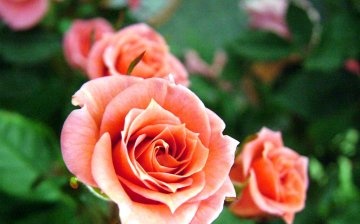
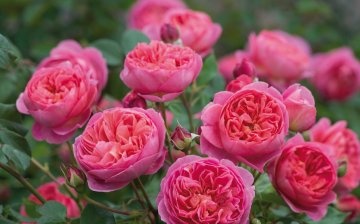
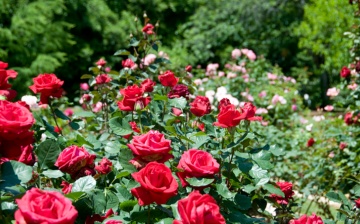

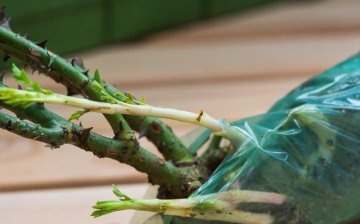

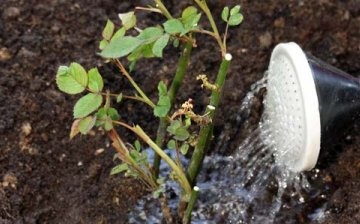
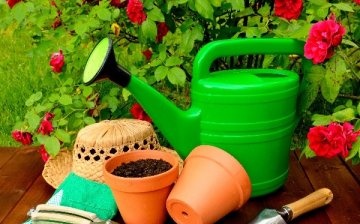

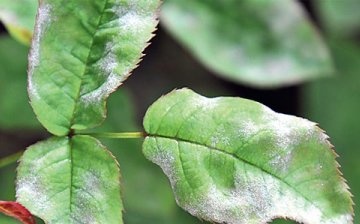
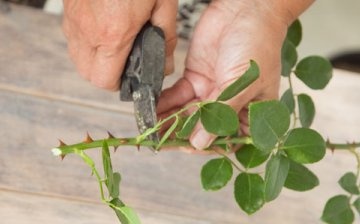

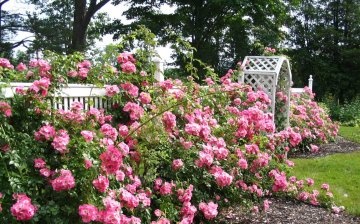













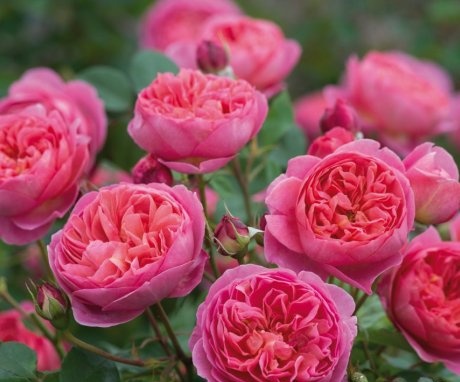
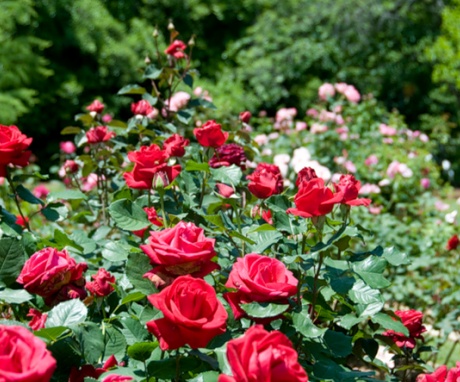
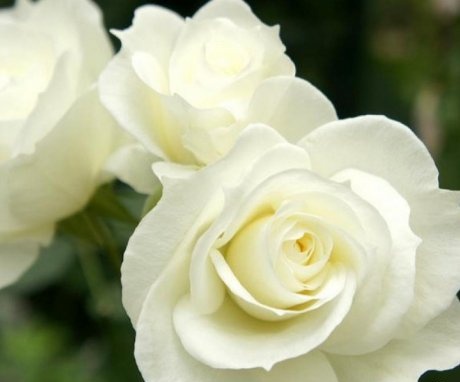
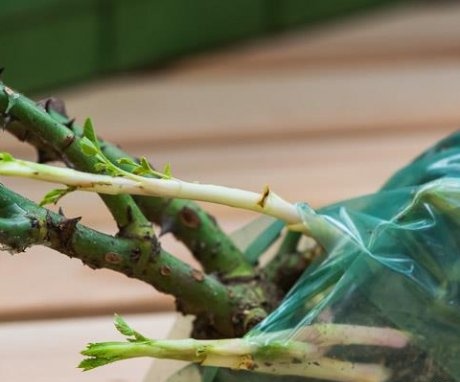
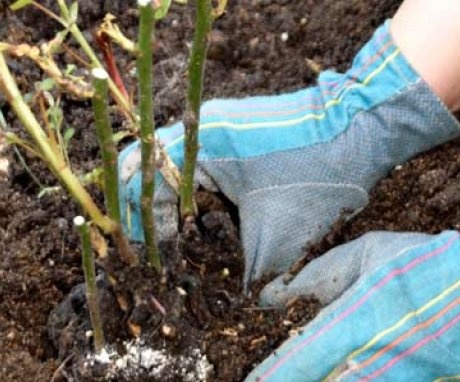
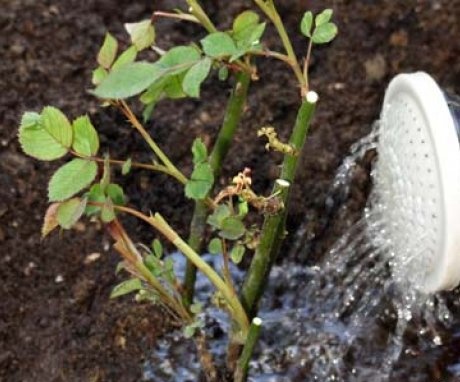
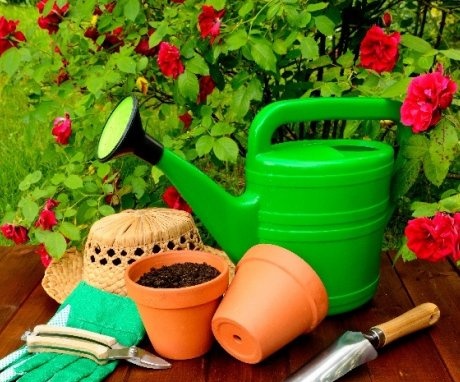
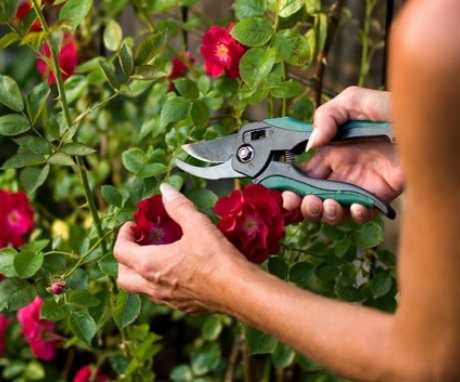
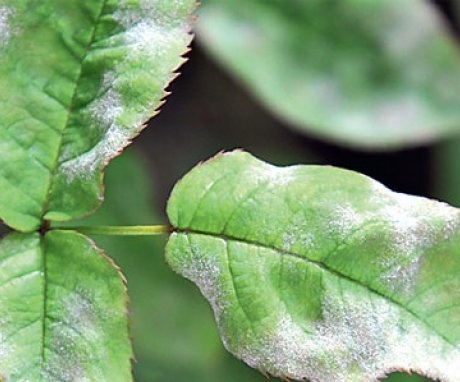
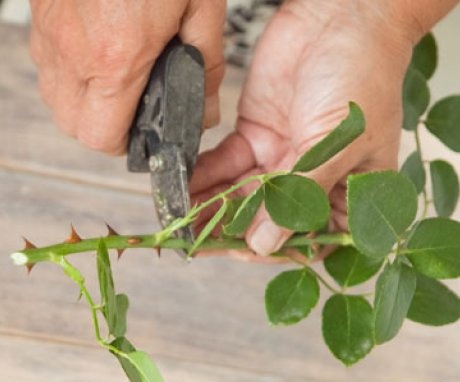
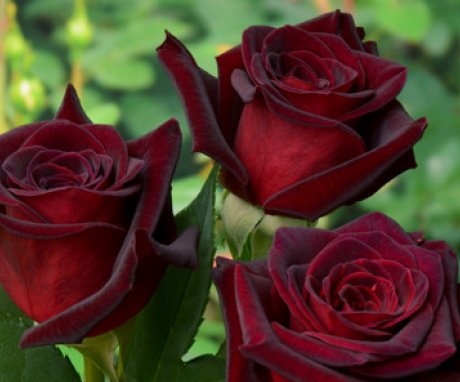
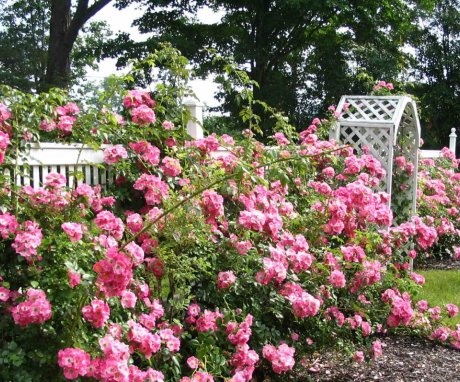
In most cases, a cultivated rose bud is grafted onto a rosehip stalk. Such a plant has all the necessary qualities of the variety, but at the same time has a high frost resistance. In the open field, the rose blooms three times in one season. If you grow it in a greenhouse, then another flowering will be added.